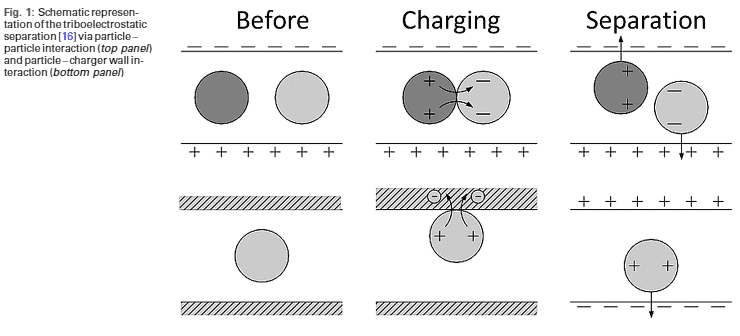Taal selecteren:
Monika Mirkowska, Markus Kratzer, Christian Teichert, en Helmut Flachberger
Abstract
Triboelectrostatic separation is a promising method used to separate non-conductive minerals. Echter, the knowledge about the underlying triboelectrification mechanisms is still very limited. Dus, predicting the separation results and finding proper separation parameters are challenging tasks. This article presents a comprehensive summary of phenomena and factors which play a decisive role in the charging behavior of non-conductors and, door implicatie, the efficiency of the separation process, such as water and adsorbents layers on the surface, oppervlakte ruwheid, vochtigheid, soort contactpersoon, enz. The authors hope that this article opens a way for a systematic approach through basic experiments dedicated to a better understanding of triboelectrification processes.
Trefwoorden: Triboelectrostatic scheiding, Triboelectrification, Contact opladen, Mineralen, Isolatoren
Belangrijkste factoren van het Triboaufladung van Mineralphasenfür een succesvolle elektrostatische scheiding - einÜberblick
Samenvatting:De elektrische scheiding vertegenwoordigt een veelbelovende methode om de Trennungnicht van geleidende minerale fasen na Triboaufla-mest. Deze beperkte de voorspelling van ongeveer als pro vooral naar scheiding resultaten aan een he uit veeleisende taak Wissenüber maakt de onderliggende mechanismen van Triboaufla-mest.
Deze publicatie zijn verschijnselen en een uitgebreide factoren over SkyView, de een de besluiten inzake de tarifering van gedrag van diëlektrica oder rol kan spelen en welke invloed op de EF-ciëntie van scheiding. Dergelijke factoren kunnen: Water- en Adsorbatschichten, Oberflächenrauig-heid, Luftfeuchtigkeit, Kontaktart, USW. Sterven Autor hoffen,Dass dieser Artikel Wege für einen systematischen Ansatzdurch grundlegende Experimente aufzeigt und damit zueinem besseren Verständnis der bei der Triboaufladungwirkenden Faktoren beiträgt.
Schlüsselwörter:Elektroscheidung, Triboaufladung,Mineralien, Isolatoren
Introductie
Triboelectrostatic scheiding is een goedkope environ-mentaal vriendelijke scheiding techniek, which has the potential to take over a greater significance of mineral processing and polymer recycling. It has been successfully applied for the separation of salts, calcite quartz, feldspar quartz, carbon as coal, and even for the purification of secondary materials like plastic. In het algemeen, it is based on triboelectrification, which is the generation of net charges on insulating powder materials by bringing powder grains into contact with each other and the device walls. De korrels, anders betalen bij contact, are separated in a strong electric field depending on the sign and amount of the charge they carry. Echter, an application as a widespread separation method is limited due to the complexity of the involved interactions, which make it technologically difficult to adjust the proper process parameters. Different factors like the behavior of the powder stream, de milieu-omstandigheden (vochtigheid, temperatuur, enz), the mechanical and electrical properties of the individual grains as well as the design of the equipment have to be considered simultaneously. Especiallytriboelectrification/contact charging is a highly non-trivial phenomenon. So far no universal model for a quantitative or even qualitative description is available. Daarom, amain focus of this work is set on contact charging phenomena. We start with a brief description of the state of the art Triboelectrostatic separation technologies in Sect. 2. The discussion is continued with reviewing factors, which determine the charging behavior of insulators in Sect. 3. There the focus is set on triboelectric charging models, charge transfer mechanisms, influences like a type of contact and environment. In sekte. 4 we provide a short overview of experimental approaches for the investigations of electrification of minerals both at the macro- and micro scale. The authors hope that the article presents the complexity of the topic and will intensify systematic interdisciplinary investigations to a better understanding of triboelectrification processes. The considerations to follow are an integral part of the first author’s Ph.D. thesis, die is in de eindfase.
